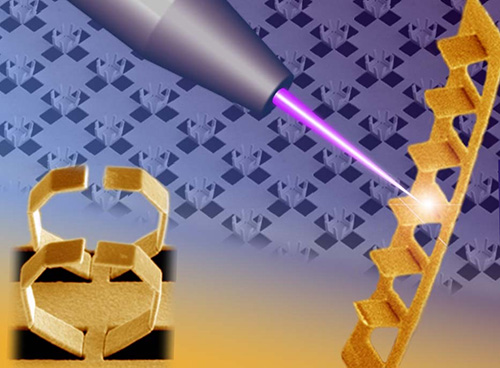Focused-ion-beam Constructed Substrate-free 3D Plasmonic "Nanograter" Structures
Date:19-10-2015 Print
In micro-/nano optics, one of the key motivations is to realize metamaterials (MMs) with effective constituent properties that can be tuned in all propagation directions at various frequencies. Techniques for fabricating millimeter-scale 3D MMs that are operational in the microwave regime are well established. However, scaling down 3D MMs that can be spatially oriented with a hierarchical geometry for applications at higher frequencies remains an active focus of research.
Focused-ion-beam is a powerful technique. It offers the unsurpassed opportunities of direct nano-scale deposition or materials removal anywhere on a solid surface precisely. During the beam-matter interaction, thermal and radiation-induced diffusion contributes to various phenomena such as mixing of constituent elements, phase transformation, crystallization, amorphization, track formation and permanent degage which potentially can be used for post-growth shape manipulation. After studying the mechanism and trends of bending of one-dimensional freestanding nanowires by FIB irradiation, recently Dr. Zhe Liu et al in Prof. GU Changzhi’s group, Dr. LI Jiafang in Prof. LI Zhiyuan’s group from the Institute of Physics, Chinese Academy of Sciences, and Prof. SHEN Tiehan in Salford University, UK and Prof. LI Hongqiang et al from Tongji University, have developed a technique for Fabrication of spatially oriented 3D nanostructures.
The fabrication process employs FIB nanopatterning combined with in situ irradiation-induced folding of metallic thin-film structures. They demonstrate that this method can be used to produce complex 3D structural elements with ease and is also feasible for the production of 2D arrays of millimeter-sized 3D elements. To demonstrate one of the optical applications, the researcher designed a 2D array of a delicate structure (named as MHVSRR) that consists of vertical U-shape split ring resonators (VSRRs) standing along an edge of rectangular metallic holes (MHs, i.e., subwavelength rectangular holes in a free-standing Au film). The MH-VSRR structures exhibit unusual Fano resonances under light excitation with an electric field polarized perpendicular to the SRR plane (U-plane), which is an unconventional polarized excitation scheme that cannot induce any resonance of a single SRR. The Fano resonance is highly sensitive to the refractive index of the surrounding medium, with a sensitivity of 2040 nm per refractive index unit (RIU) in the near-infrared (NIR) region, with potential applications in high performance plasmonic sensing.
This study entitled “Directly patterned substrate-free plasmonic ‘‘nanograter’’
Structures with unusual Fano resonances” was published on Light: Science & Applications.
The study was supported by the Technical Talent Program of the Chinese Academy of Sciences and the National Science Foundation of China.
  |
| Fig.1:Ion-beam irradiation-induced folding of in-plane Au nanostructures. (Image by Institute of Physics) |
 |
| Fig.2:Fano resonances from vertical U-shaped SRRs standing along horizontal rectangular hole arrays in a free-standing metallic film (MH-VSRRs). (Image by Institute of Physics) |
 |
| Fig. 3 Scaled-down MH-VSRRs with Fano resonances in the NIR and ultrasensitive refractive index-sensing properties. (Image by Institute of Physics) |
Contact:
Institute of Physics
LI Wuxia
Email:liwuxia@iphy.ac.cn
Key word:
Plasmonic nanostructures; Unusual Fano resonances; Substrate-free; Focused-ion-beam irradiation; Folding
Abstract:
The key motivation in producing 3D structures has always been the realization of metamaterials with effective constituent properties that can be tuned in all propagation directions at various frequencies. Focused-ion-beam direct patterning and folding reveals an effective method for scaling down fabrication of spatially oriented 3D nanostructures for applications in the infrared -visible regimes and beyond.

